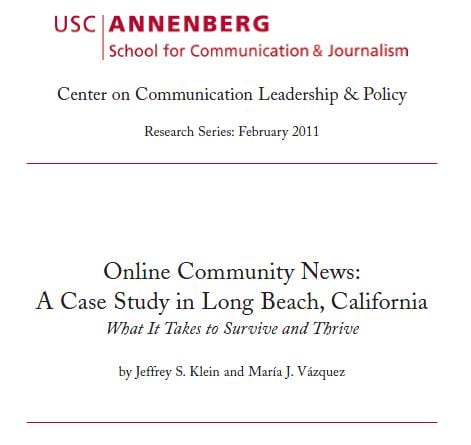
“There is a profound crisis taking place in American journalism.” That is the introductory line to the case study being published today by the USC Annenberg Center on Communication Leadership & Policy. My coauthor, María Vázquez, and I hope that this case, which focuses on the real life trials and tribulations of a four year old community news web site in a suburb of Los Angeles, will add to the admittedly parse academic literature on what some people call “hyper-local news”.
Existing news magazines and newspapers face serious threats to their continued profitability and viability. The future outlook for local print newspapers is not good. However, in the face of this threat,thousands of blogs and hyper-local community news web sites have entered the scene. The accessibility of the internet and inexpensive technology have combined to lower the barriers to entry, allowing many budding entrepreneurs to launch new efforts to try to satisfy local information needs. But it is still very unclear whether these new “businesses” will survive. Much of the early attention on these start-up enterprises has been on the “news” or content side of the business, but it is the advertising or sales side of the business that is often the most challenging. And without revenues and profits, these businesses will not make it.
The local advertising market has always been the untapped Holy Grail in the media business and now is one the fastest growing ones. Billions of dollars are spent on Yellow Pages, Classified Advertising, Coupons, Direct Mail, Weekly and Daily Newspapers, Billboards, and Cable. The competition is intensifying with the entrance of new big online players such as Groupon, Google, Facebook, Yahoo, AOL Patch and Craiglist, among others. For the smaller startups it’s a messy and challenging business to secure those advertising dollars.
Our case study, Online Community News: A Case Study in Long Beach, California — What It Takes to Survive and Thrive, shows how local online journalism works in real life. It tracks the launch and execution of a community news web site in Long Beach, California, showing how difficult it is to develop a business model that will both survive and eventually thrive.
![]() The case focuses on the challenges facing Shaun Lumachi, one of the founders of the Long Beach Post, who launched his “for-profit” venture in 2007.
The case focuses on the challenges facing Shaun Lumachi, one of the founders of the Long Beach Post, who launched his “for-profit” venture in 2007.
When Lumachi and his co-founder Robert Garcia initially developed the idea of their new online community newspaper, they saw it as a “community service.” It was only after the web site was up and running that they realized it was also a business that had to generate a profit if it was to survive and thrive long term. (They actually did consider making the business a nonprofit but decided not to go down that path.) Similar to many others who have launched hyper-local community news sites, they focused initially on the content and the technology for the site before thinking through the business model, and particularly the challenge of attracting revenue to the enterprise. They did not start with a sales strategy but developed it over time, in a series of trials and errors.
At the same time, the site was quickly a reader success, attracting a growing number of visitors and great interest from community leaders. At one point, they launched a companion site focused on local high school, college and community sports. It won editorial awards, ramped up readership, and earned praise but it turned out to be a financial drain, and was eventually merged back into the original site.
The experience of these journalism entrepreneurs is similar to many others who are trying to launch new news and information online businesses. The obstacles they faced are typical, the challenges are many. The lessons learned are valuable.
Given the dramatic changes in the news business, and the financial challenges affecting large corporate media companies, there is a growing recognition that local independent online journalism may be a strong and viable alternative to print newspapers. As a result, there is a new interest in entrepreneurship in journalism.
For journalism professors and high school teachers, this is an excellent case to have students experience the real-life challenges facing journalism entrepreneurs. Case studies are a valuable teaching tool, especially in an area which is so new that there are no established “best practices” to study. Practitioners can best learn from others who are encountering similar obstacles to their success.
For a PDF copy of the case study, click here. To see an online version of the case, including video interviews, click here. Faculty members, if you would like a copy of the Teaching Note for the case, please email vazquezmajo@gmail.com with your request.